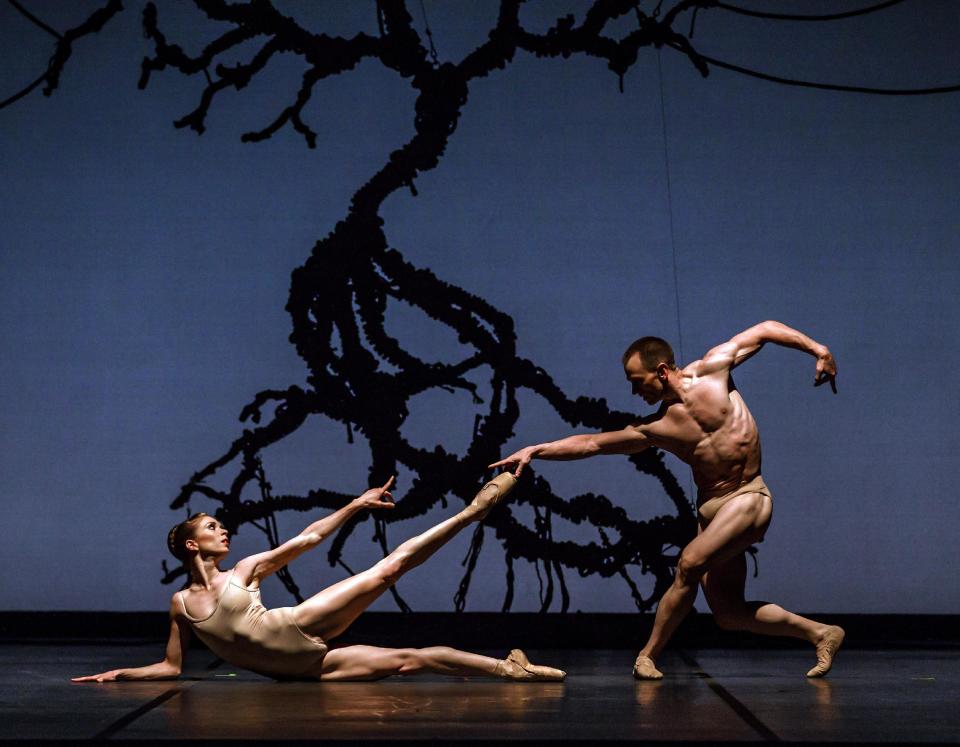Ballet about Holocaust battles intolerance
AUSTIN, Texas (AP) — Within a small rectangle of light, nearly a dozen dancers writhed and convulsed on the stage, pressed together by imaginary walls denoting some kind of death chamber.
For 12 minutes, a deafening air raid siren reverberates through the theater, as one-by-one the dancers fall out of the light, and roll into the darkness. The abstract scene with its single spotlight could represent a church in Rwanda, a labor camp in Cambodia or a gas chamber in Europe.
Choreographer Stephen Mills said his ballet, entitled "Light/The Holocaust and Humanity Project," is about all of those places — and any place — where intolerance turns into violence and genocide.
"There is a reason you don't see a boxcar, because it's not about the boxcar. It's about being forced into a situation against your will, into a situation where you are dehumanized, where you are treated less than (human), and what that does to you," Mills explained at the downtown Ballet Austin headquarters. "Hopefully it was metaphoric enough that people understood that that's the way genocides happen."
Mills created the confrontational, distinctly contemporary ballet in 2005 after spending 18 months researching the Holocaust, when Germany's Nazi party exterminated more than 6 million Jews during World War II. The ballet is set to contemporary music by Steve Reich, Evelyn Glennie, Michael Gordon, Arvo Part and Philip Glass.
Critics raved about the piece when it debuted in Austin, and the Pittsburgh Ballet performed it in 2010. Ballet Austin is now taking it on the road, performing in Miami next month, at Washington's Kennedy Center in June and at three Israeli cities in September. The Colorado Ballet will perform it in March.
Mills said his work was inspired by visits to Nazi death camps in Europe, the Holocaust memorial in Israel and interviews with Holocaust survivors, particularly an Austin woman, Naomi Warren. But he says "Light/The Holocaust and Humanity Project" is deliberately abstract to be about all forms of intolerance and violence.
"We're not going to Israel to teach anybody about the Holocaust," explained Mills, who said the harassment he's suffered as a homosexual informed his work. "I don't equate bullying with systematic murder ... but the other side of it is that suffering cannot be measured, nor can someone's capacity to endure."
"I didn't start this project because of my own demons, but through this project I was able to exorcise many of them," he said, adding that he hoped it could do the same for others.
Mills said he knows the limits of what dance can accomplish, so he works with groups such as the Anti-Defamation League, the Co-existence Project from Israel and other groups to develop educational programs that run for a month before the ballet takes the stage. In Austin, the mayor, police chief and school superintendent agreed to organize educational programs that discouraged bigotry, bullying and prejudice.
Any ballet company that wants to stage the dance must agree to organize similar programs.
"Art can only start a conversation; people solve problems. But hopefully art can be a catalyst to get people thinking about things in a way they don't ordinarily," Mills said.
In Israel, organizers want to use the ballet to address intolerance within Jewish society. In Miami and Denver the educational programs focus on anti-Semitism and bullying. In all three locations, the ballet is part of larger cultural and educational efforts.
"'Light/ The Holocaust and Humanity Project' will engage our community and keep the messages of anti-hate and anti-bigotry at the forefront of the public's psyche," said John Richard, president of the Arsht Center in Miami. "In a city so diverse it is imperative that we learn to live and work side-by-side each day."
Mills' ballet takes the audience through an emotionally-charged narrative of hatred and death, but the final scene takes a startling turn toward lightness, with a happy almost pastoral theme set in a blue light. Even Mills said he finds the ending challenging, but he wanted to stay true to what Holocaust survivors had taught him during his research.
"I'm not trying to make a pretty ballet. I'm not trying to tell a pretty story. If I had my way, we wouldn't end with the pretty blue thing," Mills said, remembering the time he spent with Holocaust survivors. "It finishes that way because Naomi says it needs to. Naomi says that at the end of all that destruction, people need to understand that there is hope, there is something afterward."


